automatic FIAT 500 2020 Owner handbook (in English)
[x] Cancel search | Manufacturer: FIAT, Model Year: 2020, Model line: 500, Model: FIAT 500 2020Pages: 228, PDF Size: 6.01 MB
Page 45 of 228
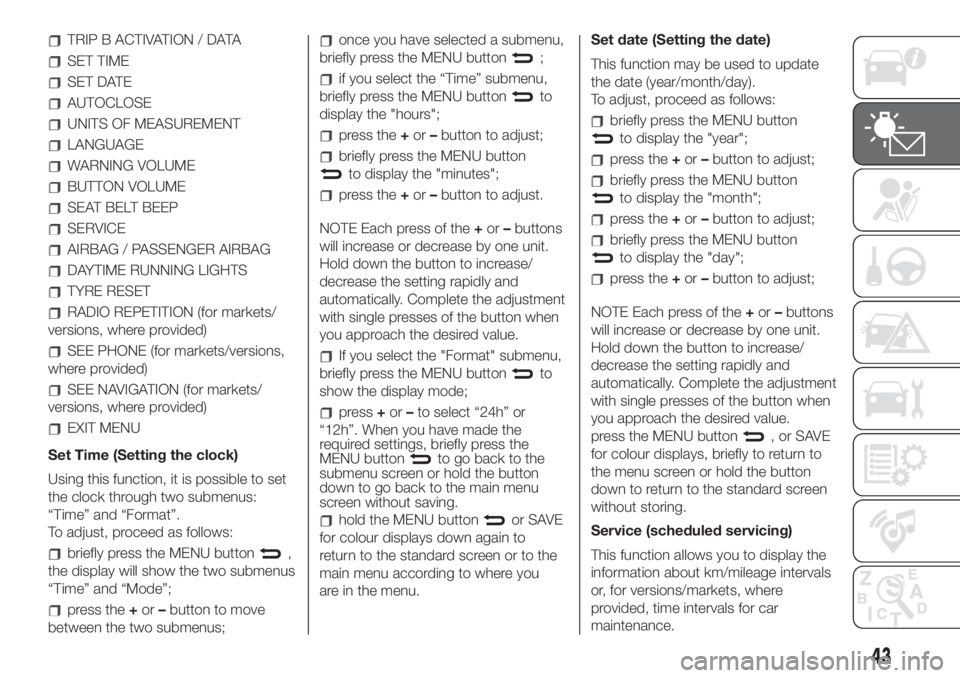
TRIP B ACTIVATION / DATA
SET TIME
SET DATE
AUTOCLOSE
UNITS OF MEASUREMENT
LANGUAGE
WARNING VOLUME
BUTTON VOLUME
SEAT BELT BEEP
SERVICE
AIRBAG / PASSENGER AIRBAG
DAYTIME RUNNING LIGHTS
TYRE RESET
RADIO REPETITION (for markets/
versions, where provided)
SEE PHONE (for markets/versions,
where provided)
SEE NAVIGATION (for markets/
versions, where provided)
EXIT MENU
Set Time (Setting the clock)
Using this function, it is possible to set
the clock through two submenus:
“Time” and “Format”.
To adjust, proceed as follows:
briefly press the MENU button,
the display will show the two submenus
“Time” and “Mode”;
press the+or–button to move
between the two submenus;
once you have selected a submenu,
briefly press the MENU button
;
if you select the “Time” submenu,
briefly press the MENU button
to
display the "hours";
press the+or–button to adjust;
briefly press the MENU button
to display the "minutes";
press the+or–button to adjust.
NOTE Each press of the+or–buttons
will increase or decrease by one unit.
Hold down the button to increase/
decrease the setting rapidly and
automatically. Complete the adjustment
with single presses of the button when
you approach the desired value.
If you select the "Format" submenu,
briefly press the MENU button
to
show the display mode;
press+or–to select “24h” or
“12h”. When you have made the
required settings, briefly press the
MENU button
to go back to the
submenu screen or hold the button
down to go back to the main menu
screen without saving.
hold the MENU buttonor SAVE
for colour displays down again to
return to the standard screen or to the
main menu according to where you
are in the menu.Set date (Setting the date)
This function may be used to update
the date (year/month/day).
To adjust, proceed as follows:
briefly press the MENU button
to display the "year";
press the+or–button to adjust;
briefly press the MENU button
to display the "month";
press the+or–button to adjust;
briefly press the MENU button
to display the "day";
press the+or–button to adjust;
NOTE Each press of the+or–buttons
will increase or decrease by one unit.
Hold down the button to increase/
decrease the setting rapidly and
automatically. Complete the adjustment
with single presses of the button when
you approach the desired value.
press the MENU button
,orSAVE
for colour displays, briefly to return to
the menu screen or hold the button
down to return to the standard screen
without storing.
Service (scheduled servicing)
This function allows you to display the
information about km/mileage intervals
or, for versions/markets, where
provided, time intervals for car
maintenance.
43
Page 46 of 228
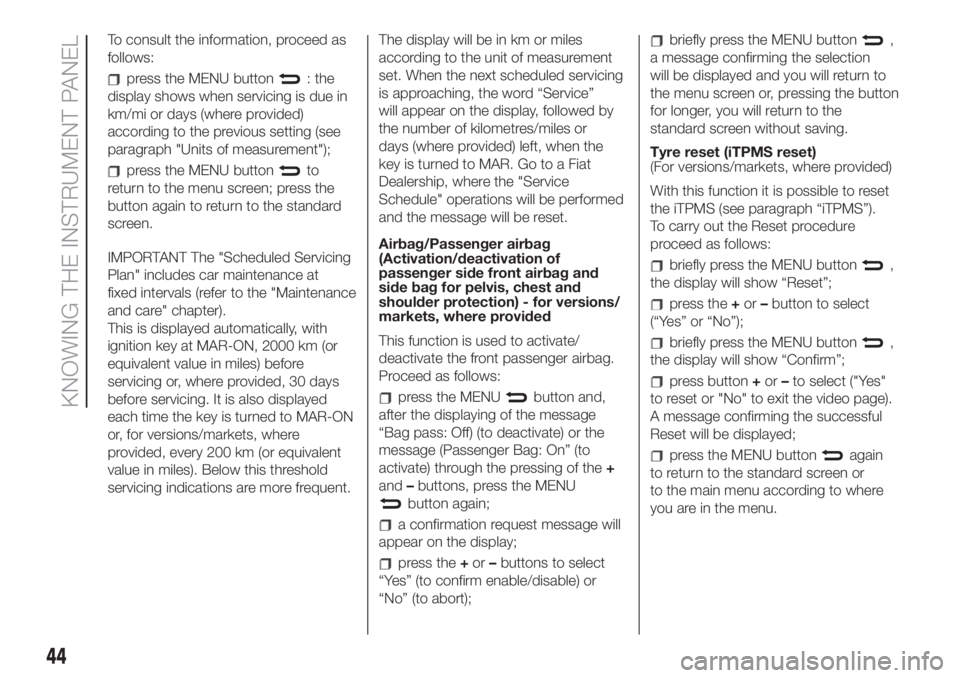
To consult the information, proceed as
follows:
press the MENU button: the
display shows when servicing is due in
km/mi or days (where provided)
according to the previous setting (see
paragraph "Units of measurement");
press the MENU buttonto
return to the menu screen; press the
button again to return to the standard
screen.
IMPORTANT The "Scheduled Servicing
Plan" includes car maintenance at
fixed intervals (refer to the "Maintenance
and care" chapter).
This is displayed automatically, with
ignition key at MAR-ON, 2000 km (or
equivalent value in miles) before
servicing or, where provided, 30 days
before servicing. It is also displayed
each time the key is turned to MAR-ON
or, for versions/markets, where
provided, every 200 km (or equivalent
value in miles). Below this threshold
servicing indications are more frequent.The display will be in km or miles
according to the unit of measurement
set. When the next scheduled servicing
is approaching, the word “Service”
will appear on the display, followed by
the number of kilometres/miles or
days (where provided) left, when the
key is turned to MAR. Go to a Fiat
Dealership, where the "Service
Schedule" operations will be performed
and the message will be reset.
Airbag/Passenger airbag
(Activation/deactivation of
passenger side front airbag and
side bag for pelvis, chest and
shoulder protection) - for versions/
markets, where provided
This function is used to activate/
deactivate the front passenger airbag.
Proceed as follows:
press the MENUbutton and,
after the displaying of the message
“Bag pass: Off) (to deactivate) or the
message (Passenger Bag: On” (to
activate) through the pressing of the+
and–buttons, press the MENU
button again;
a confirmation request message will
appear on the display;
press the+or–buttons to select
“Yes” (to confirm enable/disable) or
“No” (to abort);
briefly press the MENU button,
a message confirming the selection
will be displayed and you will return to
the menu screen or, pressing the button
for longer, you will return to the
standard screen without saving.
Tyre reset (iTPMS reset)
(For versions/markets, where provided)
With this function it is possible to reset
the iTPMS (see paragraph “iTPMS”).
To carry out the Reset procedure
proceed as follows:
briefly press the MENU button,
the display will show “Reset”;
press the+or–button to select
(“Yes” or “No”);
briefly press the MENU button,
the display will show “Confirm”;
press button+or–to select ("Yes"
to reset or "No" to exit the video page).
A message confirming the successful
Reset will be displayed;
press the MENU buttonagain
to return to the standard screen or
to the main menu according to where
you are in the menu.
44
KNOWING THE INSTRUMENT PANEL
Page 63 of 228
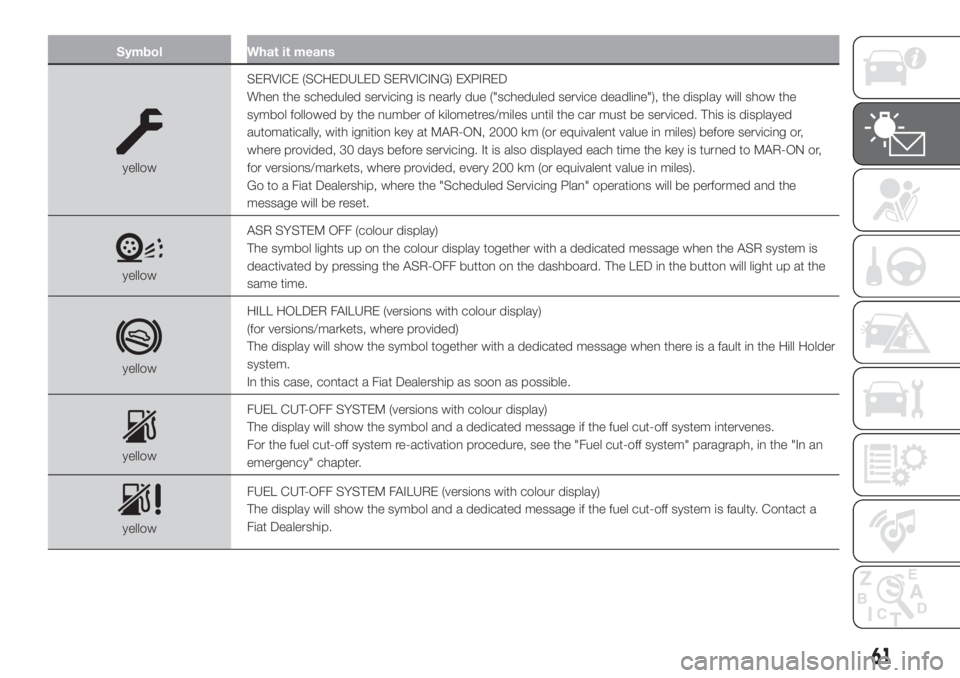
Symbol What it means
yellowSERVICE (SCHEDULED SERVICING) EXPIRED
When the scheduled servicing is nearly due ("scheduled service deadline"), the display will show the
symbol followed by the number of kilometres/miles until the car must be serviced. This is displayed
automatically, with ignition key at MAR-ON, 2000 km (or equivalent value in miles) before servicing or,
where provided, 30 days before servicing. It is also displayed each time the key is turned to MAR-ON or,
for versions/markets, where provided, every 200 km (or equivalent value in miles).
Go to a Fiat Dealership, where the "Scheduled Servicing Plan" operations will be performed and the
message will be reset.
yellowASR SYSTEM OFF (colour display)
The symbol lights up on the colour display together with a dedicated message when the ASR system is
deactivated by pressing the ASR-OFF button on the dashboard. The LED in the button will light up at the
same time.
yellowHILL HOLDER FAILURE (versions with colour display)
(for versions/markets, where provided)
The display will show the symbol together with a dedicated message when there is a fault in the Hill Holder
system.
In this case, contact a Fiat Dealership as soon as possible.
yellowFUEL CUT-OFF SYSTEM (versions with colour display)
The display will show the symbol and a dedicated message if the fuel cut-off system intervenes.
For the fuel cut-off system re-activation procedure, see the "Fuel cut-off system" paragraph, in the "In an
emergency" chapter.
yellowFUEL CUT-OFF SYSTEM FAILURE (versions with colour display)
The display will show the symbol and a dedicated message if the fuel cut-off system is faulty. Contact a
Fiat Dealership.
61
Page 67 of 228
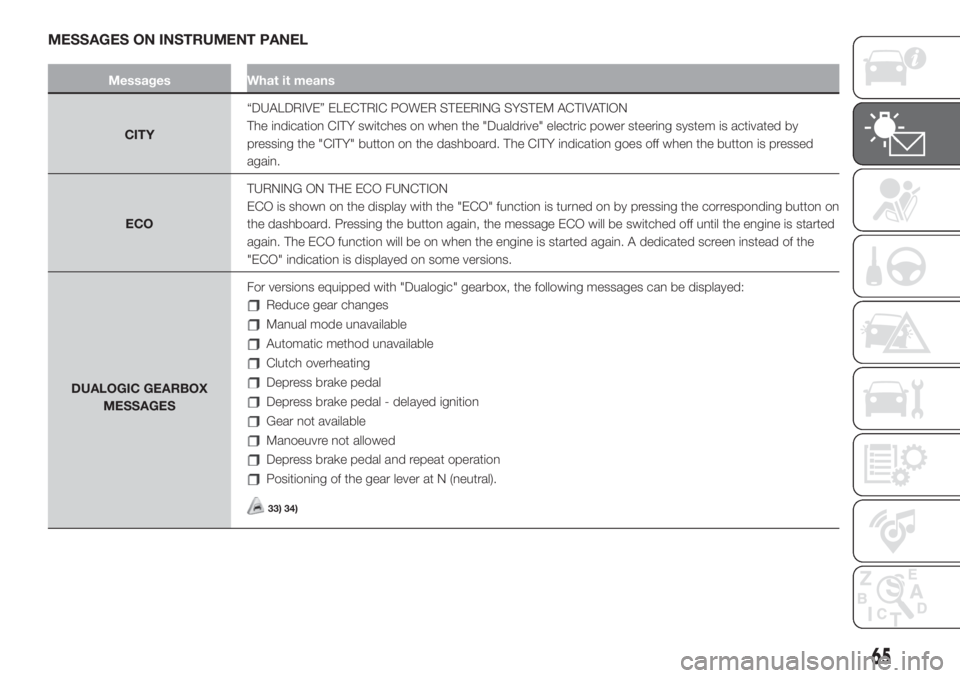
MESSAGES ON INSTRUMENT PANEL
Messages What it means
CITY“DUALDRIVE” ELECTRIC POWER STEERING SYSTEM ACTIVATION
The indication CITY switches on when the "Dualdrive" electric power steering system is activated by
pressing the "CITY" button on the dashboard. The CITY indication goes off when the button is pressed
again.
ECOTURNING ON THE ECO FUNCTION
ECO is shown on the display with the "ECO" function is turned on by pressing the corresponding button on
the dashboard. Pressing the button again, the message ECO will be switched off until the engine is started
again. The ECO function will be on when the engine is started again. A dedicated screen instead of the
"ECO" indication is displayed on some versions.
DUALOGIC GEARBOX
MESSAGESFor versions equipped with "Dualogic" gearbox, the following messages can be displayed:
Reduce gear changes
Manual mode unavailable
Automatic method unavailable
Clutch overheating
Depress brake pedal
Depress brake pedal - delayed ignition
Gear not available
Manoeuvre not allowed
Depress brake pedal and repeat operation
Positioning of the gear lever at N (neutral).
33) 34)
65
Page 70 of 228
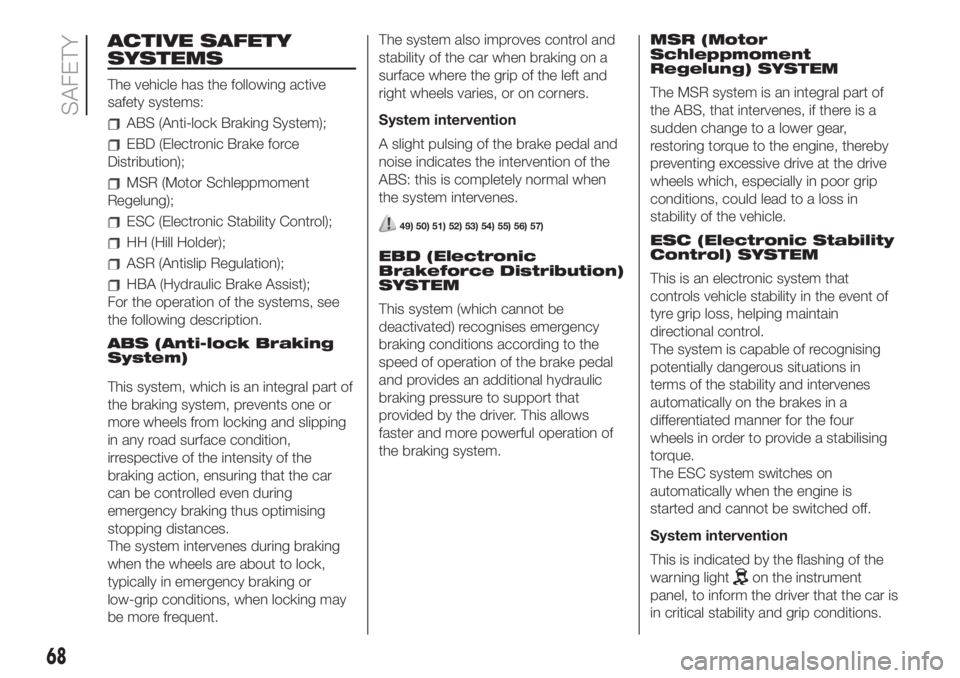
ACTIVE SAFETY
SYSTEMS
The vehicle has the following active
safety systems:
ABS (Anti-lock Braking System);
EBD (Electronic Brake force
Distribution);
MSR (Motor Schleppmoment
Regelung);
ESC (Electronic Stability Control);
HH (Hill Holder);
ASR (Antislip Regulation);
HBA (Hydraulic Brake Assist);
For the operation of the systems, see
the following description.
ABS (Anti-lock Braking
System)
This system, which is an integral part of
the braking system, prevents one or
more wheels from locking and slipping
in any road surface condition,
irrespective of the intensity of the
braking action, ensuring that the car
can be controlled even during
emergency braking thus optimising
stopping distances.
The system intervenes during braking
when the wheels are about to lock,
typically in emergency braking or
low-grip conditions, when locking may
be more frequent.The system also improves control and
stability of the car when braking on a
surface where the grip of the left and
right wheels varies, or on corners.
System intervention
A slight pulsing of the brake pedal and
noise indicates the intervention of the
ABS: this is completely normal when
the system intervenes.
49) 50) 51) 52) 53) 54) 55) 56) 57)
EBD (Electronic
Brakeforce Distribution)
SYSTEM
This system (which cannot be
deactivated) recognises emergency
braking conditions according to the
speed of operation of the brake pedal
and provides an additional hydraulic
braking pressure to support that
provided by the driver. This allows
faster and more powerful operation of
the braking system.MSR (Motor
Schleppmoment
Regelung) SYSTEM
The MSR system is an integral part of
the ABS, that intervenes, if there is a
sudden change to a lower gear,
restoring torque to the engine, thereby
preventing excessive drive at the drive
wheels which, especially in poor grip
conditions, could lead to a loss in
stability of the vehicle.
ESC (Electronic Stability
Control) SYSTEM
This is an electronic system that
controls vehicle stability in the event of
tyre grip loss, helping maintain
directional control.
The system is capable of recognising
potentially dangerous situations in
terms of the stability and intervenes
automatically on the brakes in a
differentiated manner for the four
wheels in order to provide a stabilising
torque.
The ESC system switches on
automatically when the engine is
started and cannot be switched off.
System intervention
This is indicated by the flashing of the
warning light
on the instrument
panel, to inform the driver that the car is
in critical stability and grip conditions.
68
SAFETY
Page 71 of 228
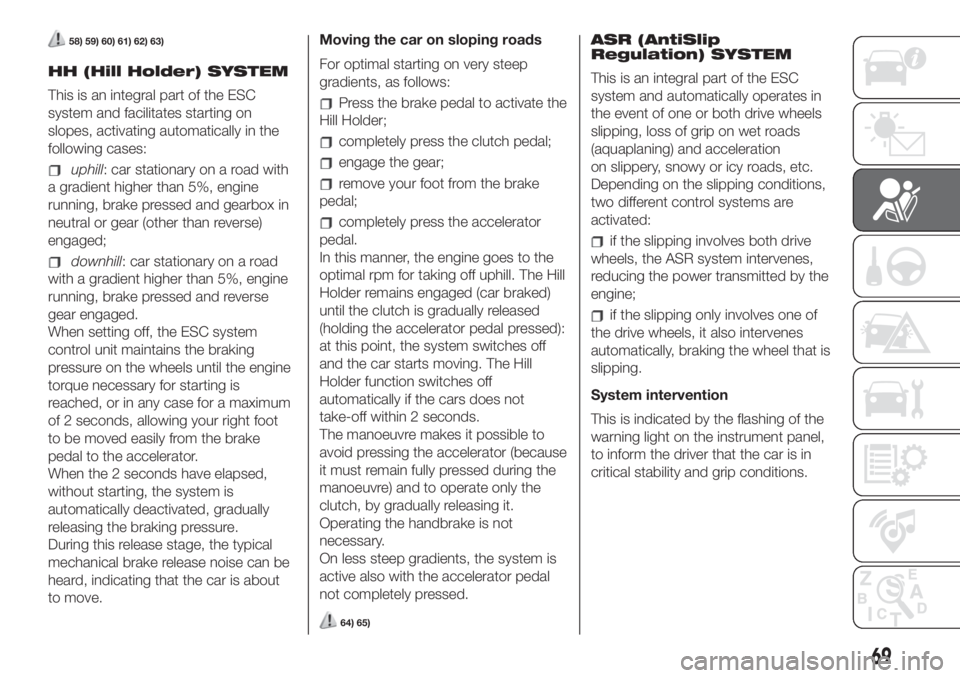
58) 59) 60) 61) 62) 63)
HH (Hill Holder) SYSTEM
This is an integral part of the ESC
system and facilitates starting on
slopes, activating automatically in the
following cases:
uphill: car stationary on a road with
a gradient higher than 5%, engine
running, brake pressed and gearbox in
neutral or gear (other than reverse)
engaged;
downhill: car stationary on a road
with a gradient higher than 5%, engine
running, brake pressed and reverse
gear engaged.
When setting off, the ESC system
control unit maintains the braking
pressure on the wheels until the engine
torque necessary for starting is
reached, or in any case for a maximum
of 2 seconds, allowing your right foot
to be moved easily from the brake
pedal to the accelerator.
When the 2 seconds have elapsed,
without starting, the system is
automatically deactivated, gradually
releasing the braking pressure.
During this release stage, the typical
mechanical brake release noise can be
heard, indicating that the car is about
to move.Moving the car on sloping roads
For optimal starting on very steep
gradients, as follows:
Press the brake pedal to activate the
Hill Holder;
completely press the clutch pedal;
engage the gear;
remove your foot from the brake
pedal;
completely press the accelerator
pedal.
In this manner, the engine goes to the
optimal rpm for taking off uphill. The Hill
Holder remains engaged (car braked)
until the clutch is gradually released
(holding the accelerator pedal pressed):
at this point, the system switches off
and the car starts moving. The Hill
Holder function switches off
automatically if the cars does not
take-off within 2 seconds.
The manoeuvre makes it possible to
avoid pressing the accelerator (because
it must remain fully pressed during the
manoeuvre) and to operate only the
clutch, by gradually releasing it.
Operating the handbrake is not
necessary.
On less steep gradients, the system is
active also with the accelerator pedal
not completely pressed.
64) 65)
ASR (AntiSlip
Regulation) SYSTEM
This is an integral part of the ESC
system and automatically operates in
the event of one or both drive wheels
slipping, loss of grip on wet roads
(aquaplaning) and acceleration
on slippery, snowy or icy roads, etc.
Depending on the slipping conditions,
two different control systems are
activated:
if the slipping involves both drive
wheels, the ASR system intervenes,
reducing the power transmitted by the
engine;
if the slipping only involves one of
the drive wheels, it also intervenes
automatically, braking the wheel that is
slipping.
System intervention
This is indicated by the flashing of the
warning light on the instrument panel,
to inform the driver that the car is in
critical stability and grip conditions.
69
Page 72 of 228

Manual engagement/release
The ASR comes on automatically
whenever the engine is started. While
driving, the ASR can be turned off
and then on again by pressing
the button A fig. 50 (ASR OFF). When
the system is not active, the LED on the
same button turns on and, on some
versions, a message appears on the
display.
If the ASR is disengaged during driving,
this is automatically reactivated at the
following car starting.
When travelling on snowy roads with
snow chains, it may be helpful to turn
the ASR off: in fact, in these conditions,
the driving wheels skidding when
moving off gives you better traction.
66) 67) 68) 69) 70) 71)
HBA (Hydraulic Brake
Assist) SYSTEM
It is an integral part of the ESC system.
The HBA system is designed to
improve the car’s braking capacity
during emergency braking.
The system detects an emergency
braking by monitoring the speed and
strength with which the brake pedal
is pressed, thereby applying the optimal
brake pressure. This can reduce the
braking distance: the HBA system
therefore completes the ABS.
Maximum assistance of the HBA
system is obtained pressing the brake
pedal very quickly; in addition, the
brake pedal should be pressed
continuously during braking, avoiding
intermittent presses, to obtain benefits
from the system.
Do not reduce pressure on the brake
pedal until braking is no longer
necessary.
The HBA system is deactivated when
the brake pedal is released.
72) 73) 74) 75) 76)
WARNING
49)When the ABS intervenes and you feel
the brake pedal pulsating, do not reduce
the pressure, but hold it down firmly and
confidently; in doing so you will brake
in the shortest distance possible,
depending on the current road conditions.
50)To obtain the maximum efficiency of
the braking system, a bedding-in period of
about 500 km is needed: during this period
it is better to avoid sharp, repeated and
prolonged braking.
51)If the ABS system intervenes, this
indicates that the traction of the tyres on
the road is about to reach its limit. You
must slow down to a speed compatible
with the available traction.
52)The ABS cannot overrule the natural
laws of physics, and cannot increase
the grip available according to the
condition of the road.
53)The ABS cannot prevent accidents,
including those due to excessive speed on
corners, driving on low-grip surfaces or
aquaplaning.
54)The capability of the ABS must never
be tested irresponsibly and dangerously, in
such a way as to compromise personal
safety and the safety of others.
55)For the correct operation of the ABS,
the tyres must of necessity be the same
make and type on all wheels, in perfect
condition and, above all, of the prescribed
type and dimensions.
50F0S0518
70
SAFETY
Page 76 of 228
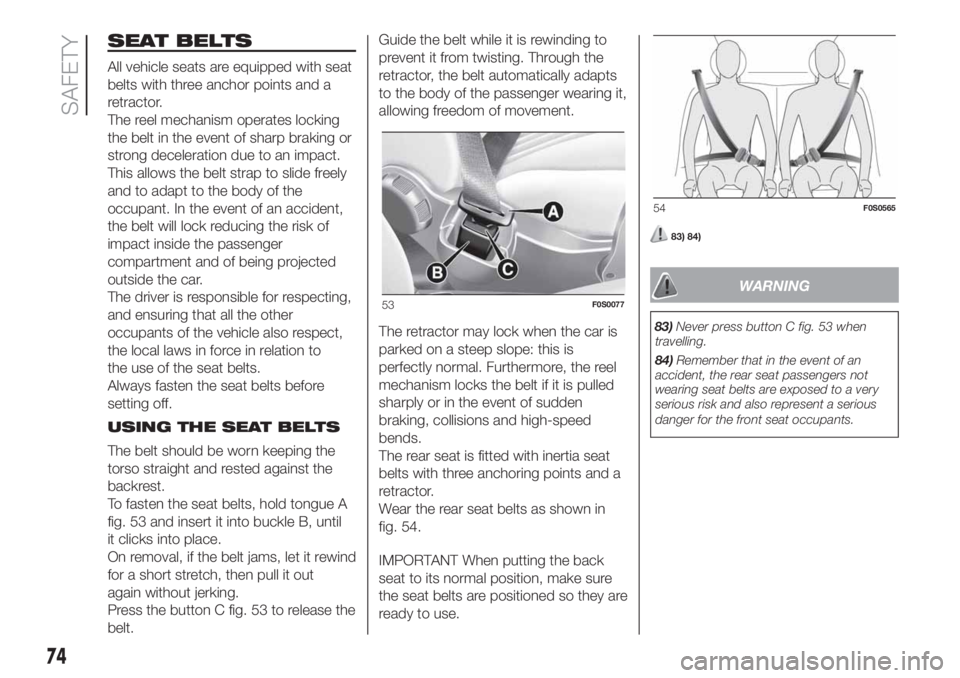
SEAT BELTS
All vehicle seats are equipped with seat
belts with three anchor points and a
retractor.
The reel mechanism operates locking
the belt in the event of sharp braking or
strong deceleration due to an impact.
This allows the belt strap to slide freely
and to adapt to the body of the
occupant. In the event of an accident,
the belt will lock reducing the risk of
impact inside the passenger
compartment and of being projected
outside the car.
The driver is responsible for respecting,
and ensuring that all the other
occupants of the vehicle also respect,
the local laws in force in relation to
the use of the seat belts.
Always fasten the seat belts before
setting off.
USING THE SEAT BELTS
The belt should be worn keeping the
torso straight and rested against the
backrest.
To fasten the seat belts, hold tongue A
fig. 53 and insert it into buckle B, until
it clicks into place.
On removal, if the belt jams, let it rewind
for a short stretch, then pull it out
again without jerking.
Press the button C fig. 53 to release the
belt.Guide the belt while it is rewinding to
prevent it from twisting. Through the
retractor, the belt automatically adapts
to the body of the passenger wearing it,
allowing freedom of movement.
The retractor may lock when the car is
parked on a steep slope: this is
perfectly normal. Furthermore, the reel
mechanism locks the belt if it is pulled
sharply or in the event of sudden
braking, collisions and high-speed
bends.
The rear seat is fitted with inertia seat
belts with three anchoring points and a
retractor.
Wear the rear seat belts as shown in
fig. 54.
IMPORTANT When putting the back
seat to its normal position, make sure
the seat belts are positioned so they are
ready to use.
83) 84)
WARNING
83)Never press button C fig. 53 when
travelling.
84)Remember that in the event of an
accident, the rear seat passengers not
wearing seat belts are exposed to a very
serious risk and also represent a serious
danger for the front seat occupants.
53F0S0077
54F0S0565
74
SAFETY
Page 96 of 228
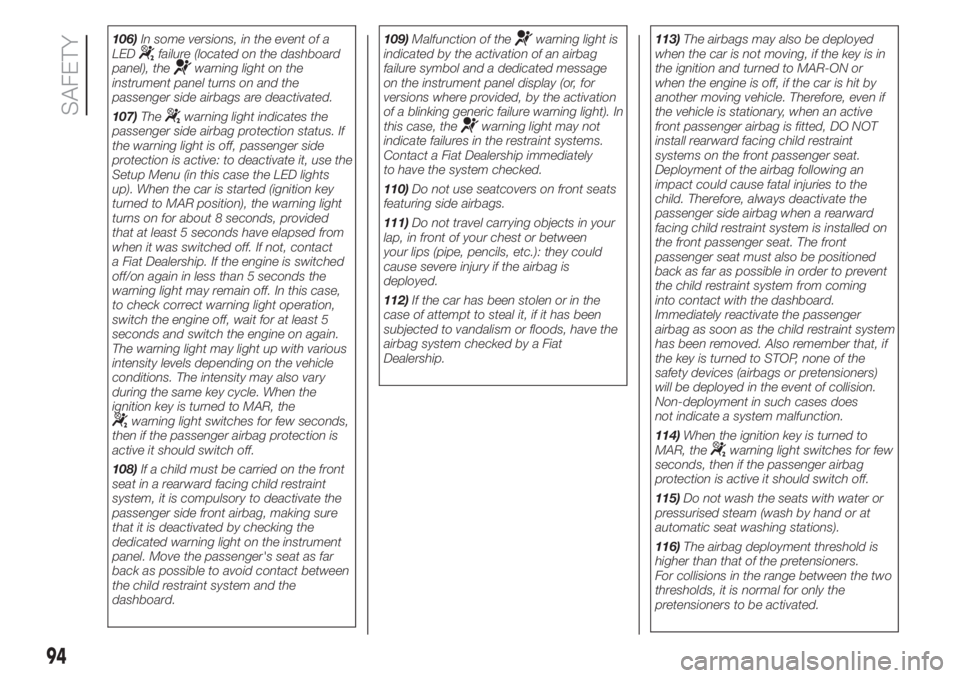
106)In some versions, in the event of a
LEDfailure (located on the dashboard
panel), thewarning light on the
instrument panel turns on and the
passenger side airbags are deactivated.
107)The
warning light indicates the
passenger side airbag protection status. If
the warning light is off, passenger side
protection is active: to deactivate it, use the
Setup Menu (in this case the LED lights
up). When the car is started (ignition key
turned to MAR position), the warning light
turns on for about 8 seconds, provided
that at least 5 seconds have elapsed from
when it was switched off. If not, contact
a Fiat Dealership. If the engine is switched
off/on again in less than 5 seconds the
warning light may remain off. In this case,
to check correct warning light operation,
switch the engine off, wait for at least 5
seconds and switch the engine on again.
The warning light may light up with various
intensity levels depending on the vehicle
conditions. The intensity may also vary
during the same key cycle. When the
ignition key is turned to MAR, the
warning light switches for few seconds,
then if the passenger airbag protection is
active it should switch off.
108)If a child must be carried on the front
seat in a rearward facing child restraint
system, it is compulsory to deactivate the
passenger side front airbag, making sure
that it is deactivated by checking the
dedicated warning light on the instrument
panel. Move the passenger's seat as far
back as possible to avoid contact between
the child restraint system and the
dashboard.109)Malfunction of the
warning light is
indicated by the activation of an airbag
failure symbol and a dedicated message
on the instrument panel display (or, for
versions where provided, by the activation
of a blinking generic failure warning light). In
this case, the
warning light may not
indicate failures in the restraint systems.
Contact a Fiat Dealership immediately
to have the system checked.
110)Do not use seatcovers on front seats
featuring side airbags.
111)Do not travel carrying objects in your
lap, in front of your chest or between
your lips (pipe, pencils, etc.): they could
cause severe injury if the airbag is
deployed.
112)If the car has been stolen or in the
case of attempt to steal it, if it has been
subjected to vandalism or floods, have the
airbag system checked by a Fiat
Dealership.113)The airbags may also be deployed
when the car is not moving, if the key is in
the ignition and turned to MAR-ON or
when the engine is off, if the car is hit by
another moving vehicle. Therefore, even if
the vehicle is stationary, when an active
front passenger airbag is fitted, DO NOT
install rearward facing child restraint
systems on the front passenger seat.
Deployment of the airbag following an
impact could cause fatal injuries to the
child. Therefore, always deactivate the
passenger side airbag when a rearward
facing child restraint system is installed on
the front passenger seat. The front
passenger seat must also be positioned
back as far as possible in order to prevent
the child restraint system from coming
into contact with the dashboard.
Immediately reactivate the passenger
airbag as soon as the child restraint system
has been removed. Also remember that, if
the key is turned to STOP, none of the
safety devices (airbags or pretensioners)
will be deployed in the event of collision.
Non-deployment in such cases does
not indicate a system malfunction.
114)When the ignition key is turned to
MAR, the
warning light switches for few
seconds, then if the passenger airbag
protection is active it should switch off.
115)Do not wash the seats with water or
pressurised steam (wash by hand or at
automatic seat washing stations).
116)The airbag deployment threshold is
higher than that of the pretensioners.
For collisions in the range between the two
thresholds, it is normal for only the
pretensioners to be activated.
94
SAFETY
Page 99 of 228
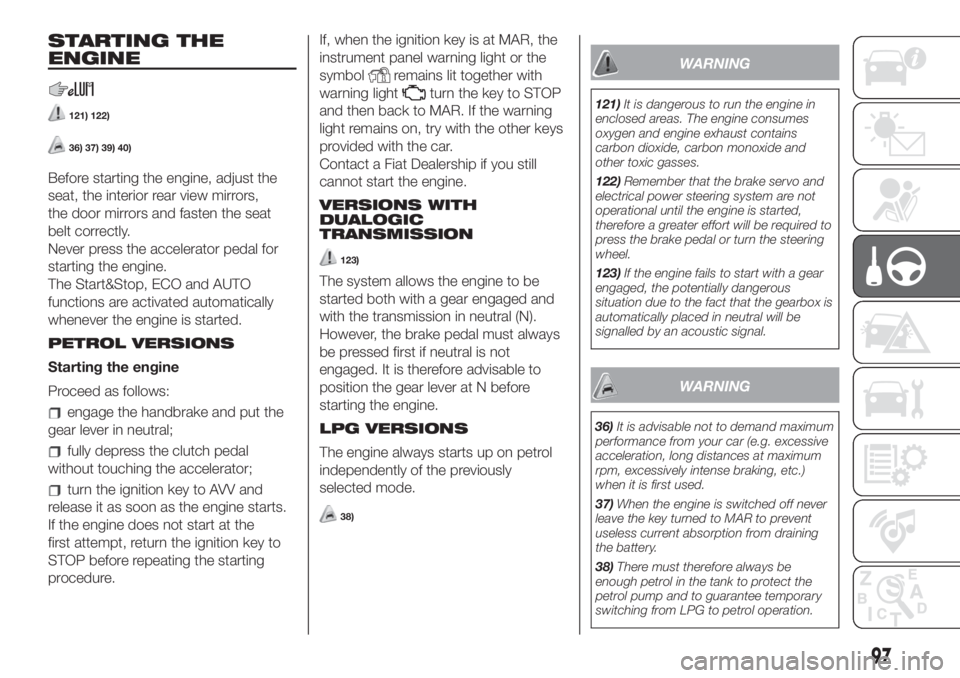
STARTING THE
ENGINE
121) 122)
36) 37) 39) 40)
Before starting the engine, adjust the
seat, the interior rear view mirrors,
the door mirrors and fasten the seat
belt correctly.
Never press the accelerator pedal for
starting the engine.
The Start&Stop, ECO and AUTO
functions are activated automatically
whenever the engine is started.
PETROL VERSIONS
Starting the engine
Proceed as follows:
engage the handbrake and put the
gear lever in neutral;
fully depress the clutch pedal
without touching the accelerator;
turn the ignition key to AVV and
release it as soon as the engine starts.
If the engine does not start at the
first attempt, return the ignition key to
STOP before repeating the starting
procedure.If, when the ignition key is at MAR, the
instrument panel warning light or the
symbol
remains lit together with
warning light
turn the key to STOP
and then back to MAR. If the warning
light remains on, try with the other keys
provided with the car.
Contact a Fiat Dealership if you still
cannot start the engine.
VERSIONS WITH
DUALOGIC
TRANSMISSION
123)
The system allows the engine to be
started both with a gear engaged and
with the transmission in neutral (N).
However, the brake pedal must always
be pressed first if neutral is not
engaged. It is therefore advisable to
position the gear lever at N before
starting the engine.
LPG VERSIONS
The engine always starts up on petrol
independently of the previously
selected mode.
38)
WARNING
121)It is dangerous to run the engine in
enclosed areas. The engine consumes
oxygen and engine exhaust contains
carbon dioxide, carbon monoxide and
other toxic gasses.
122)Remember that the brake servo and
electrical power steering system are not
operational until the engine is started,
therefore a greater effort will be required to
press the brake pedal or turn the steering
wheel.
123)If the engine fails to start with a gear
engaged, the potentially dangerous
situation due to the fact that the gearbox is
automatically placed in neutral will be
signalled by an acoustic signal.
WARNING
36)It is advisable not to demand maximum
performance from your car (e.g. excessive
acceleration, long distances at maximum
rpm, excessively intense braking, etc.)
when it is first used.
37)When the engine is switched off never
leave the key turned to MAR to prevent
useless current absorption from draining
the battery.
38)There must therefore always be
enough petrol in the tank to protect the
petrol pump and to guarantee temporary
switching from LPG to petrol operation.
97